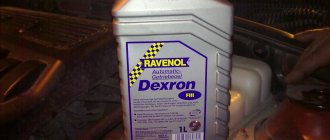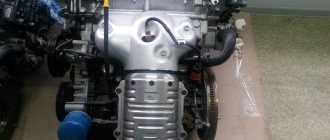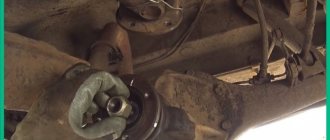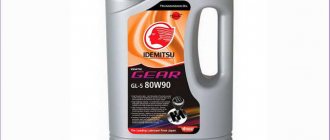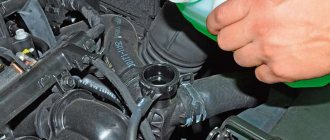Hyundai Solaris is a compact budget car for the Russian market, introduced in 2010. The first generation car was produced in St. Petersburg in sedan and hatchback bodies, which were equipped with 1.4 and 1.6 liter gasoline engines (107-123 hp). Transmissions are 5-speed manual or 4-speed automatic, and after the 2014 restyling, a 4-speed automatic became available. In 2022, the second generation Solaris debuted, built on the basis of the previous model.
Despite the more modern exterior and interior design, Solaris II is structurally no different from the 2010 model. In addition, the car is equipped with modernized 1.4 and 1.6 engines (99-124 hp), which work with similar manual and automatic transmissions familiar from the first generation. Sales of the updated Hyundai Solaris began in 2022.
The most popular articles on the site:
- How often should you change engine oil?
- Oil 5w30 and 5w40 what is the difference
- What oil to pour into the engine in winter and summer
- How long does it take to change the automatic transmission oil?
When to change power steering oil
The oil change schedule for the Hyundai Solaris power steering is 50-100 thousand km. The newer the car and the more favorable the operating conditions, the longer the oil shelf life. However, during sudden maneuvers and lane changes, there is a high probability that the oil will quickly lose its beneficial properties and ultimately lead to clogging of the hydraulic system.
In this case, if the replacement is untimely, the oil will have to be changed along with the filter elements. Spoiled fluid is also one of the reasons for the deterioration of feedback on the steering wheel, which must be turned with great effort. The tightness of power steering pipelines at their attachment points is also often broken.
Replacement frequency
Car service specialists recommend changing the power steering fluid in the Hyundai Solaris after 60 thousand kilometers. Replacement is required before this date if turning the steering wheel requires increased effort or the pump is too noisy.
The frequency of oil changes is affected by:
- Intensity of vehicle use
- Driving style
- Frequency of fixing the steering wheel in the extreme position
- Duration of parking a car with the front wheels turned out
Color classification
How much fuel does Hyundai solaris consume?
It is wrong to be guided only by color gradation when choosing oil, although this practice is widespread among car owners. It is also often indicated what color liquids can be mixed and which ones should not be mixed.
Mixing is contraindicated with liquids based on composition and not color, and since now both mineral water and synthetics can be presented in any color, you should treat this information very carefully. Red ATF gear oil, usually synthetic, the Dexron brand from General Motors is considered the reference, but there are products from other manufacturers, such as Revenol, Motul, Shell, Zic, etc.
Yellow oil, produced by the Daimler concern and under its license, is used in Mercedes-Benz hydraulic boosters. Available in synthetic and mineral
Red ATF gear oil is usually synthetic, the Dexron brand from General Motors is considered the standard, but there are products from other manufacturers, such as Revenol, Motul, Shell, Zic, etc. Yellow oil, produced by the Daimler concern and under its license, is used in Mercedes-Benz hydraulic boosters. It can be synthetic and mineral.
Green oil. For the most part, multifunctional and universal liquids can be either synthetic or mineral in composition. They are used in power steering, suspension and other systems that operate on liquids. It cannot be mixed with other colors, except in cases where the manufacturer declares full compatibility, for example Comma PSF MVCHF is compatible with some types of Dexron.
How to pump power steering
How to fill oil and bleed power steering
- Raise the vehicle completely on a lift or with the front wheels off the ground.
- If necessary, drain the old fluid from the expansion tank. To do this, remove the return hose (going to the power steering system) from the expansion tank and put a plug on it so that liquid does not spill out of the hose. A hose leading to an empty bottle is connected to the released tap on the tank, where the old hydraulic fluid is supposed to be drained.
- It is most convenient to pump out the main volume of liquid with a syringe and pour it into a separate bottle. When there is very little liquid left, move on to the next point.
- Fill the expansion tank with working fluid to the top.
- Next, you should turn the steering wheel from side to side (from lock to lock) several times so that the old fluid remaining in the system flows out through the hose. Since the new fluid displaces the old, do not forget to monitor the oil level in the tank so that air does not get into the hose.
- If the fluid level drops, add it again.
- Start the engine for 2-3 seconds and turn it off. This is done so that the liquid begins to spread throughout the system.
It is important to remember that if you have aired the power steering system, the air can be expelled by bleeding it by rotating the steering wheel from side to side. However, do not start the engine under any circumstances, since the air in the system is critical for the power steering pump and can cause its failure.
Pumping out oil with a syringe
- Next, add working fluid to the tank to the MAX level and repeat the procedure by starting the engine. Repeat this cycle 3-5 times.
- The signal to stop pumping is the fact that air from the return hose stops entering the drain bottle. This means that there is no more air left in the hydraulic system and fresh, clean fluid enters the reservoir.
- After this, you need to reinstall the return hose (connect it to the expansion tank where it was originally installed).
- Refill the reservoir to the MAX level, then start the engine.
- To pump the hydraulic booster, you need to slowly turn the steering wheel 4-5 times from the left to the right stop. At the stop points, pause for 2-3 seconds. If there is any air left, it should escape into the expansion tank. During the inspection process, we make sure that the pump does not make any extraneous noise.
- An indicator that pumping has ended will be the absence of air bubbles on the surface of the liquid in the tank.
- After this, close the expansion tank tightly.
Bleeding the power steering system
can also be pumped without starting the engine , “cold”. To do this, just rotate the steering wheel from the left to the right stop . At the same time, old fluid and air leave the system. However, most automakers still recommend bleeding the system with the engine running.
The fluid level in the reservoir should be between the MIN and MAX marks . Remember that when heated, the liquid expands, so you should not pour it beyond the existing mark.
Analogue or original? Which gur to choose
Let's start with the original and move on to analogues along the way.
The car used one version of the hydraulic booster for absolutely any configuration and engine. There are two articles in the catalog: 57100-4L000 and 57100-4L001. Before 2015 it was set to 57100-4L000, after - the next one. I don’t know what’s causing the number change. Everything is the same.
The hydraulic booster has been used by the company since 2006. and has two additional articles that are not in the catalog: 57100-2F601 and 57100-1M000.. The differences are in the tube and metal bracket, which can be rearranged from the old pump. Usually the price of these is lower.
Difference in bracket and tube
Need a new original, use all numbers. Ask sellers to announce the price for each number. They usually only use directory data.
Recently, the story about MANDO+ has been widespread. MANDO+ is no different from most cheaper analogues.
What is the main difference between the original and analogues? Advantages and disadvantages.
- Minuses:
- All other things being equal, the resource is lower.
- There is a marriage. It doesn't happen often, but it does happen. After installation, the buzzer may hum for some time. You'll have to travel for up to two or three days. The howling does not go away, which means the pump is defective. Always keep your receipt.
- There may be no or a different type of sensor responsible for the stability of idle speed when the steering wheel is rotated. Without it, the engine may shake a little.
Steering sensor
- Pros:
- The difference in price is up to 3.5 times.
- A decent resource in most cases.
- Easy to buy, stores keep duplicates in stock. The original usually needs to be ordered and waited.
Below is a list of manufacturers and numbers of hydraulic boosters. The items that were used in the repair are marked in green. No other experience.
Analogs
I will add SAT and STELLOX power steering. Usually the cheapest options.
Company guide SAT ST-VP70
STELLOX 00-36351-SX
How to replace or remove the hydraulic booster
The gur is located between the engine and the engine shield. Before work, it is necessary to drain the fluid from the system.
Remove the drive belt. If the work is carried out in a garage without a pit, it is better to remove the wheel and use a 14 key to press the tensioner towards the engine shield. There is no tension, the belt can be removed by hand. For more details, see the “Drive Belt Tensioner” section.
Unscrew the lower hydraulic booster mounting bolt.
Let's go to the engine compartment. Remove the chip and disconnect the wiring from the bracket. If a non-original steering wheel is installed, the sensor may be missing.
Unscrew the power steering hose (green arrows) and the upper mounting bolt (yellow arrow).
All that remains is to remove the bracket and the return tube. You can disassemble it on the car or the removed power steering.
Engine rear view
Choice of composition for power steering
The performance and service life of the unit depends on the production and quality of the liquid that is poured into the Solaris power steering. It is always better to opt for authentic products from the Korean automaker.
Its price may be slightly higher than its analogues, but road safety requires the use of only high-quality factory-made compounds and oils. Competitors may make products just as good, but you should only use them after consulting with your dealer.
It is better to buy a Hyundai Kia ULTRA PSF-4; the technical documentation for early generation versions allows the possibility of using ULTRA PSF-3. Knowing what brand of fluid has already been filled into the Hyundai power steering, you can determine the mixing order.
Mixing is carried out according to a strict rule: the fourth brand can be poured into the third, but not more than 50% of the total amount of the mixture. The reverse situation is excluded.
Reviews
Leonid, Tomsk. Solaris is also Solaris in Africa - we have a dime a dozen of them, especially first-generation cars. I remember a similar story happened with the Matiz, which my wife enjoys driving. I have a 2015 Solaris - a restyled version with a more stylish face and additional options. The unpretentious 1.6 engine consumes 10-11 liters.
Daria, Belgorod. I am the owner of a second generation Solaris, purchased last year. The car is from the first owner, a 2017 model with a 1.4 engine (100 hp) and manual transmission. A good and proven option for working in a taxi. Despite its simple and proven design, Solaris, with a mileage of 63 thousand km, has never failed.
Tips for using power steering
In order for the hydraulic booster to work normally and not knock, you must follow a few simple rules:
- Monitor the oil level in the power steering system, top up and change it on time. In addition, check its condition. There is always a risk of purchasing a low-quality liquid, which becomes unusable after a short period of use (check its color and smell).
- Do not hold the wheels in the extreme position (both left and right) for a long time (more than 5 seconds). This is harmful for the power steering pump, which operates without cooling.
- When parking the vehicle, always leave the front wheels level (straight). This will take the load off the power steering system the next time you start the engine. This advice is especially relevant in cold weather, when the oil thickens.
- If problems occur with the power steering (humming, knocking, increased effort when turning the steering wheel), do not delay repairs. You will not only fix the breakdown at a lower cost, but also protect your car, you and your loved ones from possible emergency situations.
- Constantly monitor the condition of the steering rack. This is especially true for the condition of anthers and seals. This way you will not only extend its service life, but also save money on expensive repairs.

